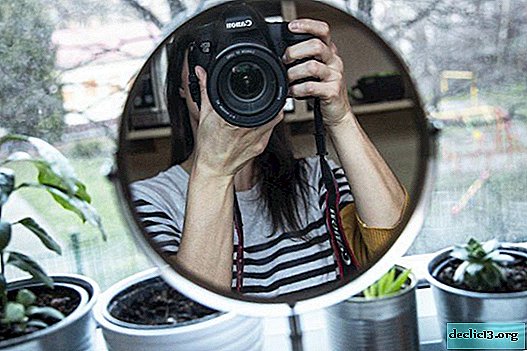Spectacular rose Sophia Loren: in detail about the form, care of the flower and propagation

Rose Sophia Loren is an amazing variety belonging to the Rosaceae family. Flowers received such a unique and magnificent name, cannot but please you with their correspondence to the famous image.
It is appreciated by flower growers due to resistance to diseases and weather conditions, as well as the incredible beauty of buds.
But only the right care and cultivation will allow the flowers to bloom for a long time and delight others.
Description and photo
The buds of a rose are pointedly rounded, bright red in color. Petals have a velvety surface. Sophia Loren belongs to hybrid tea varieties, which are characterized by repeated flowering. At the stage of full blooming, the average size of the flowers reaches 12 cm.
The peculiarity of the species is a large number of velvety petals, so the bush looks elegant and decorative. The plant blooms in single flowers or in inflorescences, which are located on powerful, straight stems. The sheet plate is leathery, dark green in shape, resembling an egg. The height of the bush reaches 150 cm. There are also large, but rare spikes.
Grade Advantages:
- high winter hardiness;
- disease resistance - black spotting;
- ability to withstand prolonged waterlogging;
- high decorative properties;
- long flowering period.
The minuses of the variety should include high requirements for the place of growth and the need for regular pruning of shoots.
See how this variety looks in the photo:



Variety History
Sophia Loren cultivar was bred in Germany in 1967. Because of its beauty and showiness, it was named after the famous actress Sophia Loren.
What is the difference from the rest of the pink species?
After cutting flowers, they are able to maintain their shape and fresh appearance for a long time.Besides, the plant can grow in a cold climate. You can grow bushes in a greenhouse or in open ground.
Bloom
When and how does it bloom?
Sophia Loren blooms throughout the summer. At this time, the bushes are strewn with bright red flowers with raspberry tint. The buds are lush and large, as the diameter reaches 12 cm.
Care before and after
Roses do not require special care during flowering. They need to be regularly watered, but water stagnation must be avoided. It is worth feeding with the predominance of potassium and phosphorus. Faded and dried flowers must be removed in a timely manner, as this will stimulate the bush to form new buds.
What to do if it does not bloom?
 If the rose does not bloom, then first you need to find out the cause, and only then look for ways to eliminate it:
If the rose does not bloom, then first you need to find out the cause, and only then look for ways to eliminate it:
- Poor soil quality. It is best to plant bushes in the soil, previously mixed with sand.
- Lack of or excess fertilizer. If you add nitrogen compounds in an increased amount, then the plant will form leaves, not buds.
- No bush pruning. If you do not remove the weakened and dried branches, then this will adversely affect the development of the bush, as a result of which its flowering will stop.
Use in landscape design
Hybrid tea roses are widely used in landscape design. And this is not surprising, since they have an attractive appearance. Thanks to this, Sophia Loren is actively used as a plentifully blooming background for other plants.
A combined hedge looks elegant and modern, in which roses will show off in the foreground, and evergreens or deciduous plants appear in the background.
Sophia Loren looks great with a pungent buttercup, soft cuff and gypsophila. You should not plant late varieties of peonies with large roses, large-flowered dahlias and tuberous begonias.Care
Seat selection
For planting, it is worth using a darkened place, but only it should be well warmed up. You can not plant a bush in the sun. In order for roses to grow in the shade, it is better to plant them near trees and fruit bushes.
Time
Planting a plant is better in autumn or spring. If the latter option is chosen, then it is worth considering that after winter the seedlings are weakened. But planting in the fall is considered more favorable, because after winter storage the seedlings have time to take root.
What should be the soil?
For these plants, the soil should be light and slightly acidic. If there is heavy soil in the selected area, then it is recommended to add sand to it when planting.
Landing
 When choosing a seedling, you need to pay attention to its external condition. It should have several kidneys and a developed root. And leaves, buds and fruits should be absent. The neck of the root in size should not exceed 1 cm.
When choosing a seedling, you need to pay attention to its external condition. It should have several kidneys and a developed root. And leaves, buds and fruits should be absent. The neck of the root in size should not exceed 1 cm.
Planting roses can occur in a greenhouse or in open ground. The optimal size of the pit will be 50 * 50 * 50 cm. Then it will be possible to freely position the root system, allowing the roots to straighten out in the thickness of the earth.
There are 2 options for planting young seedlings - dry and wet. The selection of the appropriate method is determined by soil moisture. The dry method involves the classic digging of a hole and falling asleep seedlings with prepared soil. The wet option is based on filling the landing pit with soil that has been moistened to a state of porridge.
During the landing, you need to form a knoll at the bottom so that the root system can straighten out. When a bush falls asleep, it is required to establish the vaccination site strictly below the ground. Due to this arrangement, the seedling will not freeze in the winter, and in the summer wild shoots will not form on the bush.
Temperature
In summer, for the variety in question, the temperature should not exceed 30 degrees, and it is necessary to prepare it for wintering at a temperature of -10 degrees.
Watering
Humidification of the soil is one of the main conditions for the successful cultivation of roses. This will allow the bushes to bloom repeatedly and plentifully. With a lack of moisture or its excess, the buds will develop poorly, and the flowers will fade. Watering is required once a week, and when the summer is dry, then 2-3 times a week.
Top dressing
The quality and duration of flowering are positively affected by mineral and organic fertilizers. In the spring, urea should be used as the first top dressing. At the stage of the active formation of buds, fertilizing with potassium-phosphorus compounds (10-12 g per 10 liters of water) will be required.
Weeding
Weeding is necessary with a hoe.. But sometimes it is not enough: parts of the weed roots remain in the soil, from which a new plant then develops.
Weed control is desirable before planting a seedling.Mulching
This procedure allows you to better maintain soil moisture. You can use compost for mulching.
Loosening
To better aerate the roots and prevent weeds, it is necessary to loosen the soil periodically. This procedure is performed after watering.
Pruning
Preventative
It is performed immediately after harvesting the material covering the flowers in winter. Preventive pruning consists in pruning under the base of sick and frozen stems. Damaged shoots must be left at the height of a healthy kidney. In addition, it is necessary to cut weakened stems, if this does not harm the plant.
Formative
It is necessary to form a rose bush in the first summer after planting. Small and growing inward must be cut out under the ring. Similarly, they do with shoots coming from the root neck or the site of vaccination. Long and intensely growing shoots must be nipped. In June, the formation of the bush when pruning is completed.
Transfer
Sophia Loren is best done in the fallobserving the following recommendations:
 Dig a hole with a small handful of fertile soil and carefully place the plant.
Dig a hole with a small handful of fertile soil and carefully place the plant.- At the bottom of the pit can be laid drainage. To do this, use the following components: river sand, gravel or small stones.
- Spread the roots inside the flowerbed well.
- Water again and bury the hole completely.
- The soil must be carefully compacted so that there are no air jams.
- When the first frosts occur, the roots of the plant must be reliably covered.
Preparation for winter
Cutting roses before winter is not necessary, as this will lead to repeated flowering. It is enough just to cover the bush with polyethylene or pour an additional layer of soil.
How to propagate?
It is necessary to harvest cuttings after the shoots form buds or after the first flowering. Procedure:
- Cut off the shoots from the central part. Their length is 5-8 cm. Also, 2-3 leaves should be present on the shoot.
- To reduce evaporation, remove the bottom sheet and part of the top.
- Before planting, place the cuttings in the root stimulator for 18-20 hours.
- It is necessary to plant a prepared seedling early in the morning or in the evening.
- Coarse kiln sand, a mixture of sand and peat (1: 1) are used as a substrate.
- Pour a layer 3-4 cm thick over sod-humus soil.
- Plant the cuttings obliquely, deepening by 1.5-2 cm.
- Cover the seedlings in the garden with glass or plastic jars, and on top with plastic wrap.
Diseases and Pests
Sophia Loren variety is highly resistant to fungal diseases. But there are insects that can significantly harm the plant:
- aphid;
- scale shield;
- leaflet;
- pennies.
Sophia Loren is an amazing variety of roses, which is simple in terms of care and delights others not only with the beauty of velvet buds, but also with a pleasant aroma.

 Dig a hole with a small handful of fertile soil and carefully place the plant.
Dig a hole with a small handful of fertile soil and carefully place the plant.















